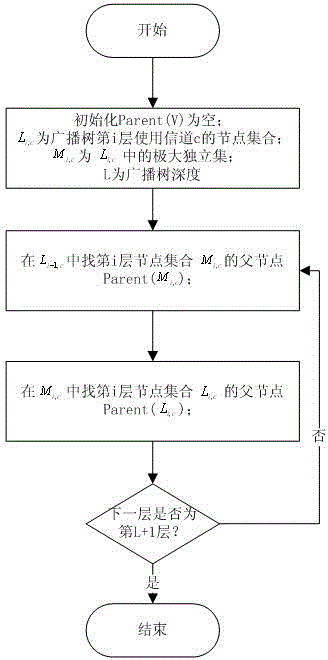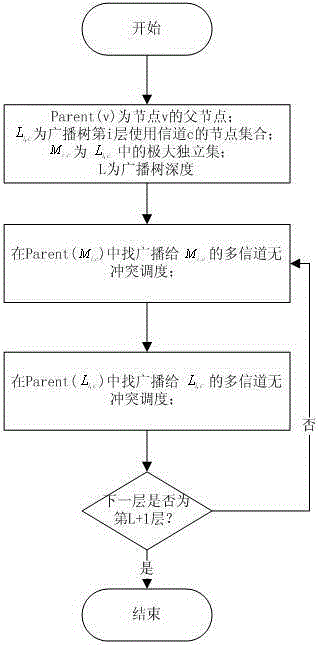Centralized Broadcast Scheduling Method for Single-Interface Multi-Channel Wireless Network
A technology of broadcast scheduling and wireless network, applied in the field of wireless network and information dissemination, can solve the problem of not considering the particularity of broadcast service, and achieve the effect of improving broadcast efficiency and network performance
- Summary
- Abstract
- Description
- Claims
- Application Information
AI Technical Summary
Problems solved by technology
Method used
Image
Examples
specific Embodiment
[0027] Concrete embodiment comprises the steps:
[0028] Phase 1: Layering of Network Nodes
[0029] The main purpose of this phase is to layer all nodes in the network. For the network topology graph G(V,E) from the source node Start to run the breadth-first algorithm and construct a breadth-first tree (Breadth-FirstTree) with a depth of l. In this way, all the nodes in the network can be layered according to the depth of the tree. For example, the nodes in the i-th layer are To represent.
[0030] Phase 2: Determine the parent-child node broadcast structure
[0031] The main purpose of this stage is to determine the broadcast structure and determine the broadcast parent node of each node in the network. Such as figure 2 As shown, the specific steps are as follows:
[0032] Step 1: Set of nodes using channel c for layer i Add nodes in running order, so that the newly added nodes are not adjacent to the nodes in the existing set, and determine a maximum independent...
PUM
 Login to View More
Login to View More Abstract
Description
Claims
Application Information
 Login to View More
Login to View More - R&D
- Intellectual Property
- Life Sciences
- Materials
- Tech Scout
- Unparalleled Data Quality
- Higher Quality Content
- 60% Fewer Hallucinations
Browse by: Latest US Patents, China's latest patents, Technical Efficacy Thesaurus, Application Domain, Technology Topic, Popular Technical Reports.
© 2025 PatSnap. All rights reserved.Legal|Privacy policy|Modern Slavery Act Transparency Statement|Sitemap|About US| Contact US: help@patsnap.com



